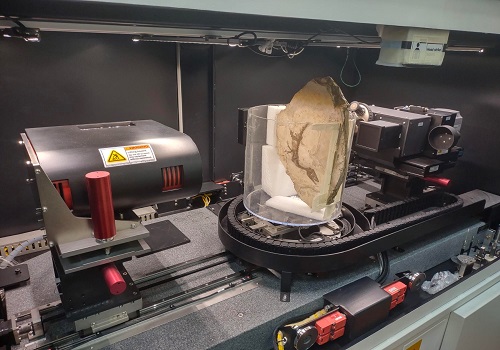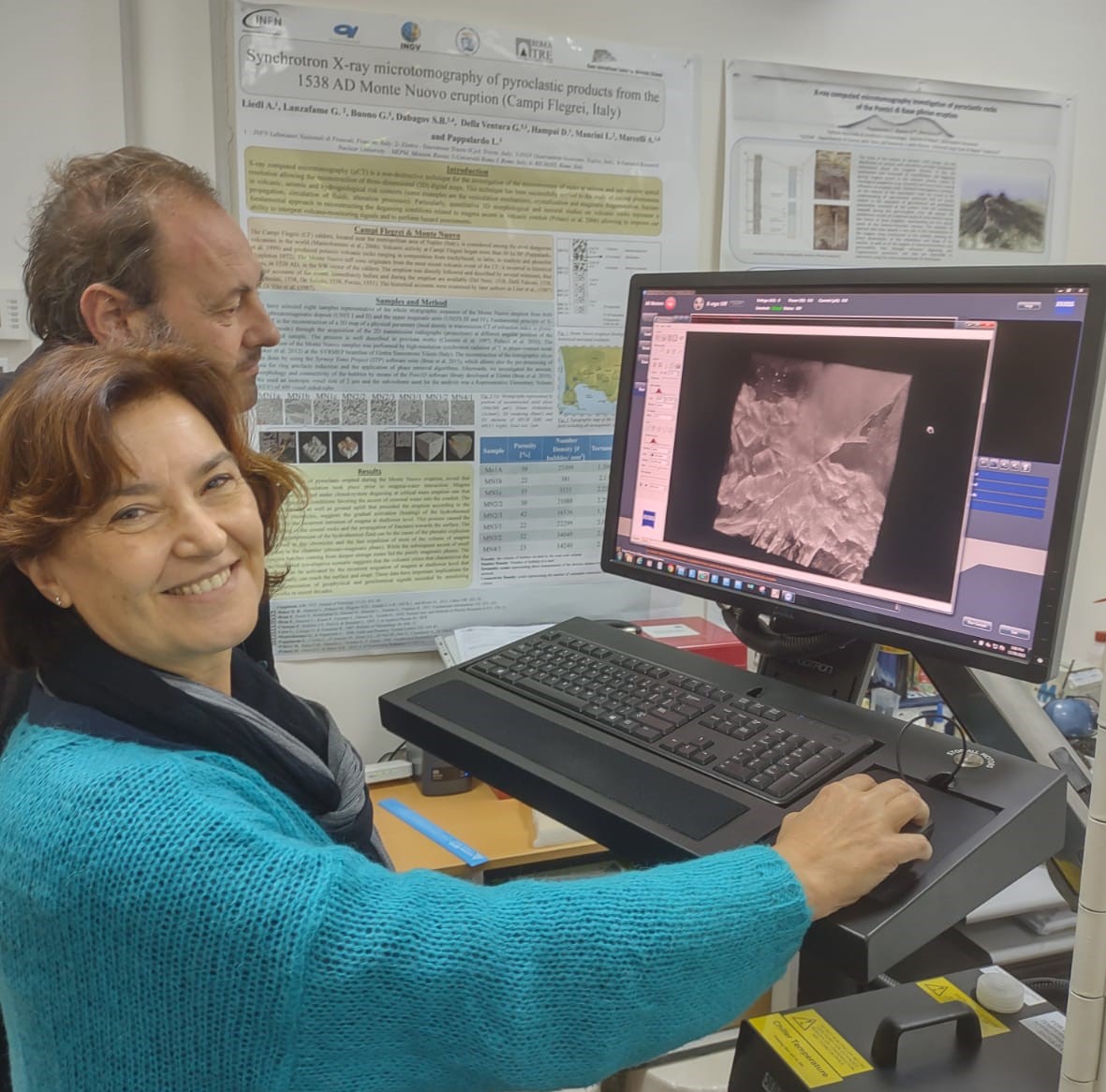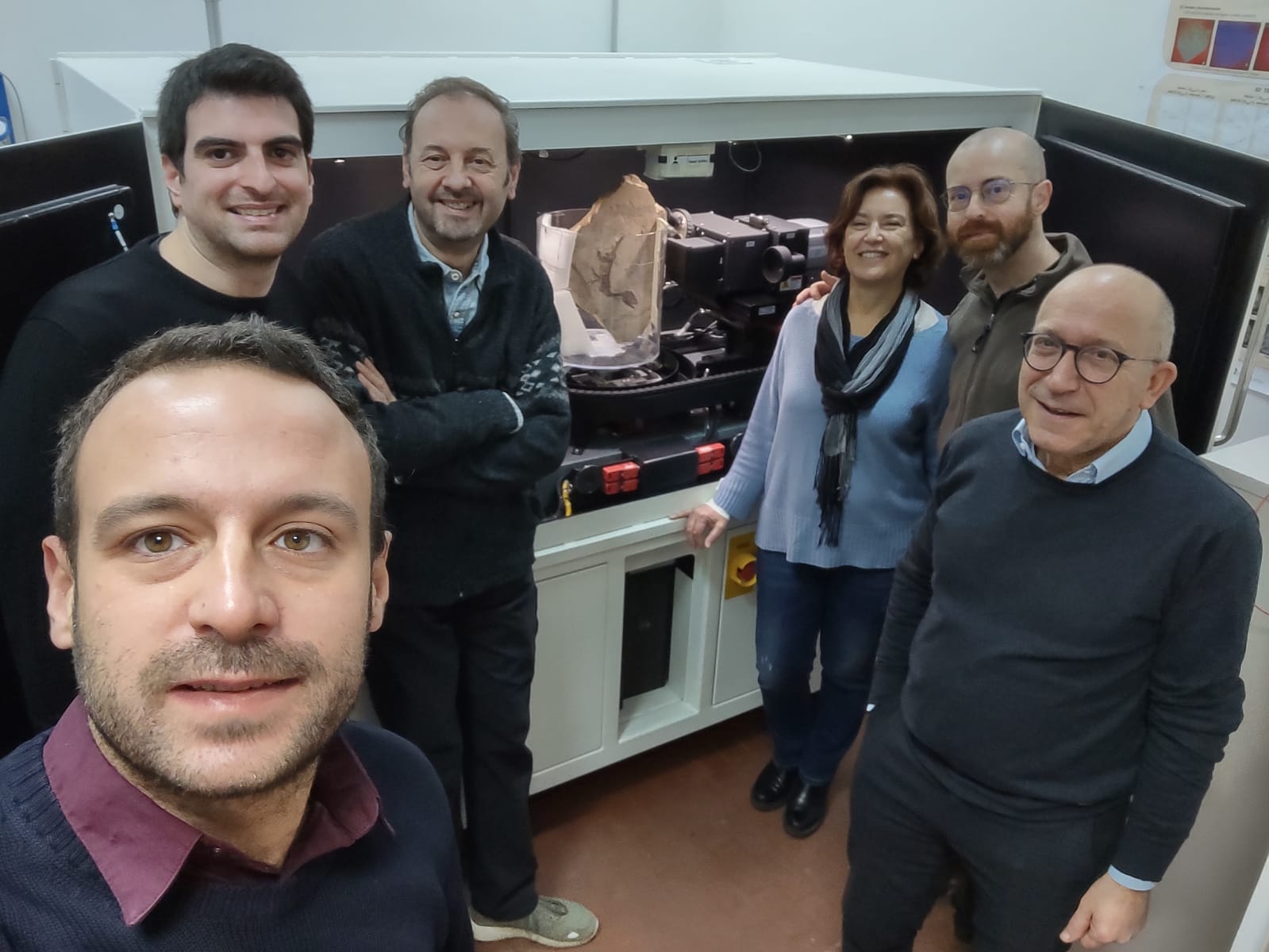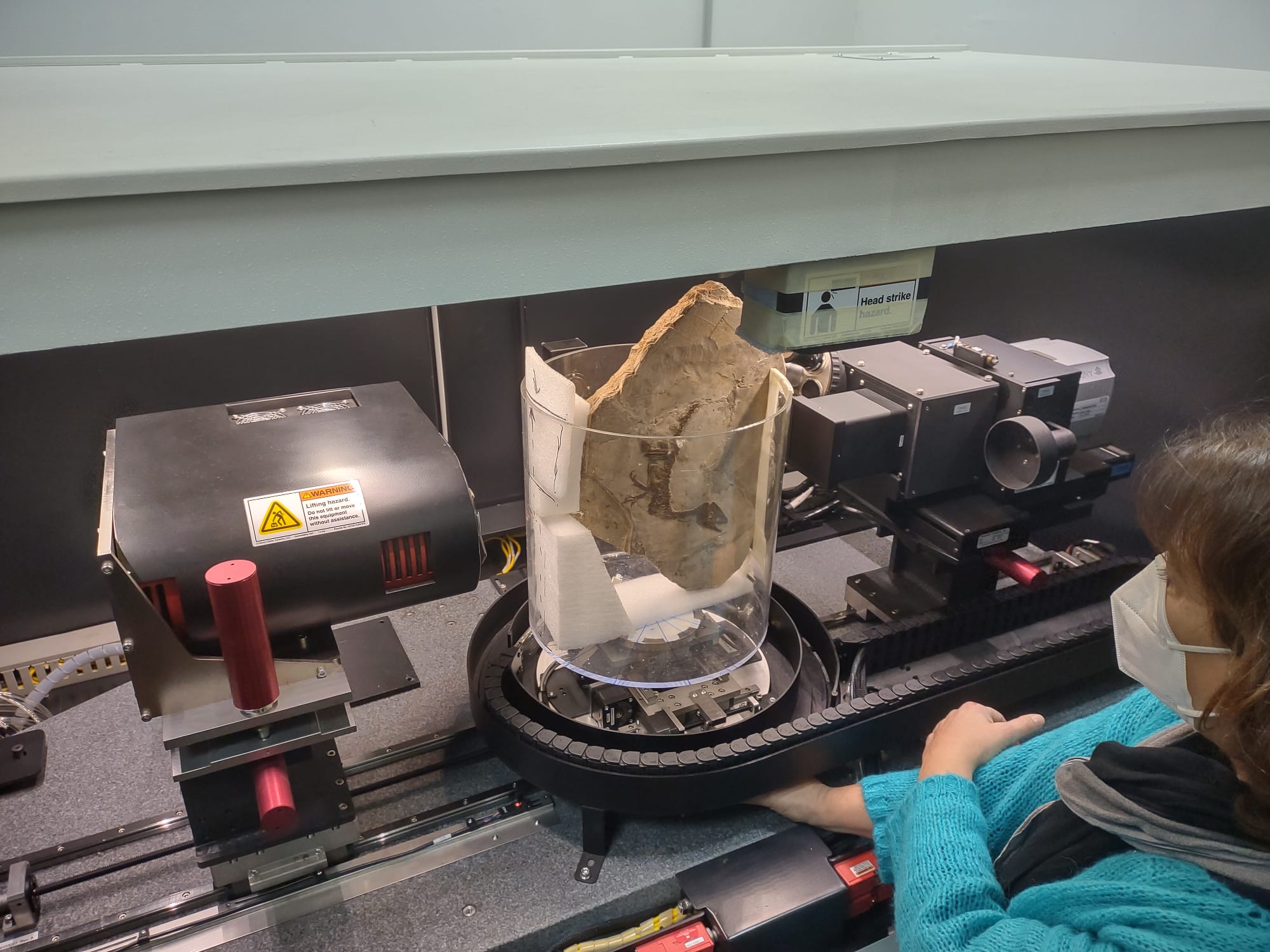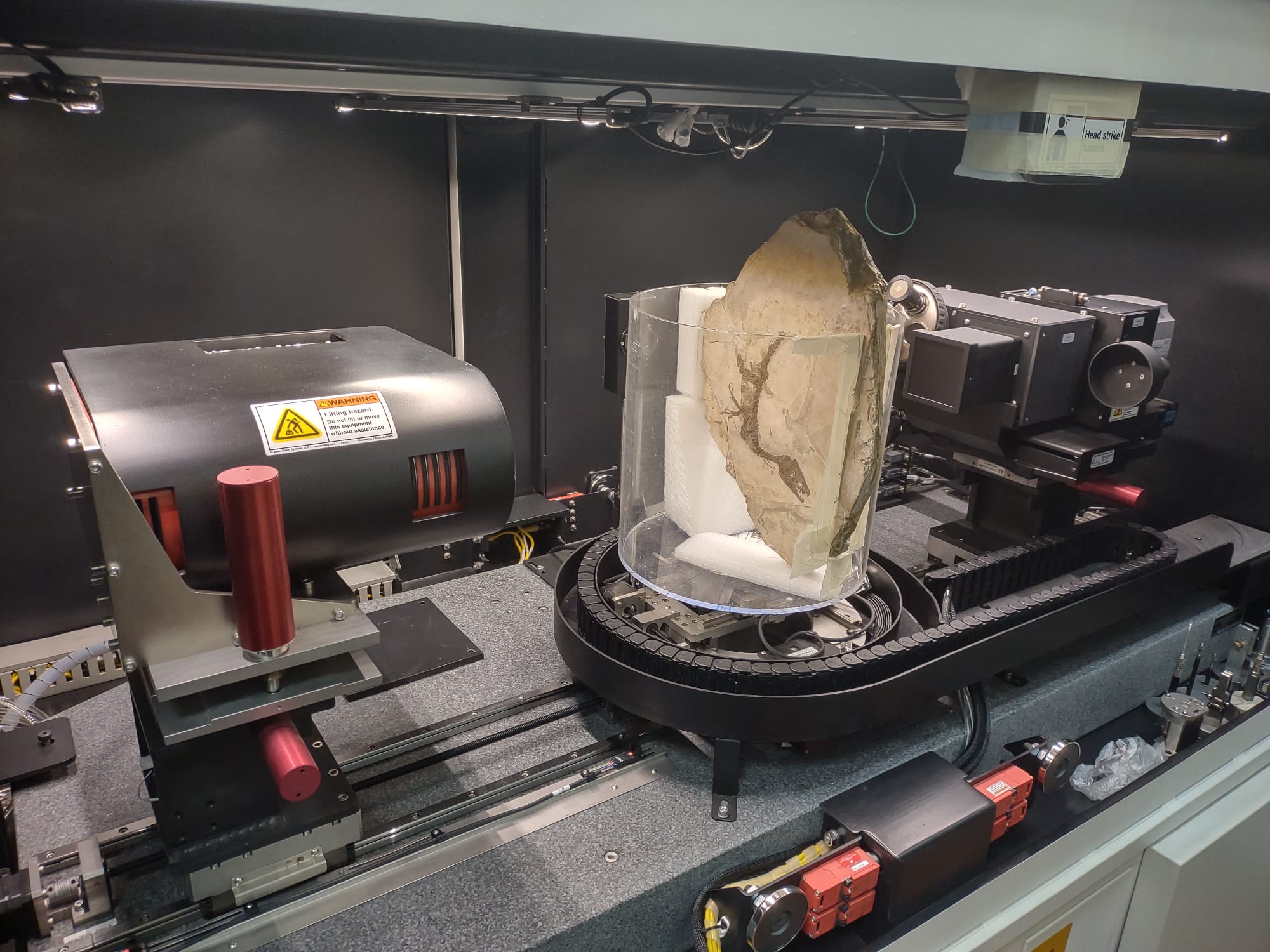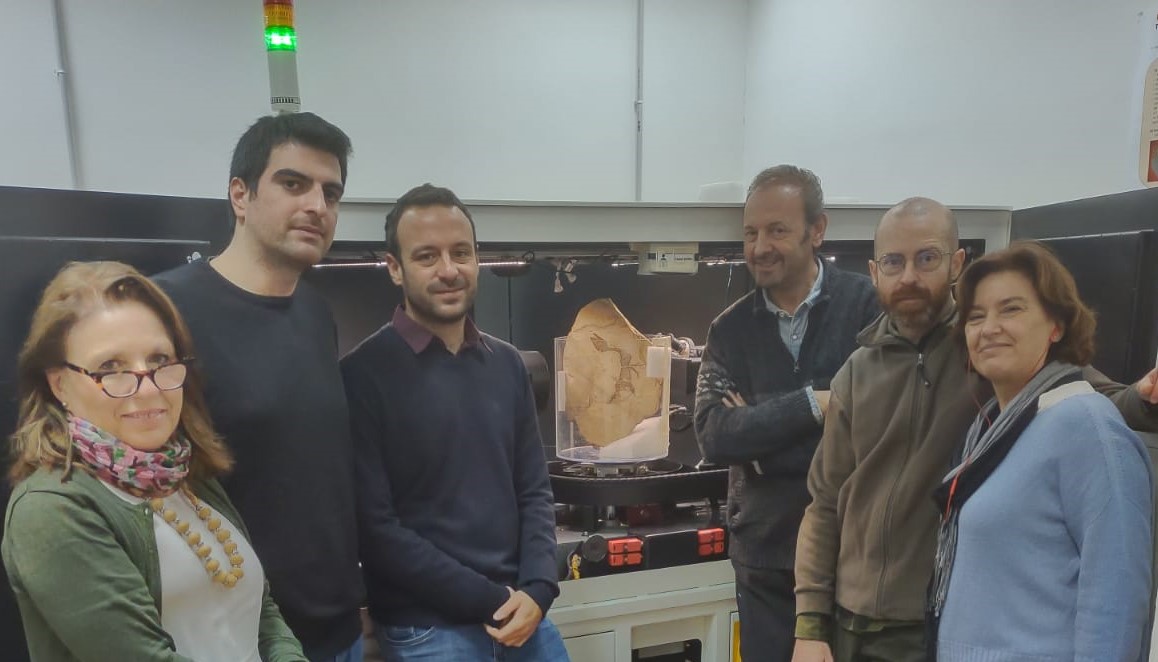La tecnologia usata nella vulcanologia a disposizione della paleontologia: una sinergia scientifica nuova per conoscere sempre meglio il piccolo “Ciro”, il più famoso dinosauro italiano
Il Laboratorio di microtomografia dell’Osservatorio Vesuviano dell’Istituto Nazionale di Geofisica e Vulcanologia (INGV) ha messo a disposizione dei paleontologi una tecnologia innovativa impiegata nello studio delle rocce vulcaniche.
Scopo delle attività dei ricercatori dell’INGV è raccogliere sezioni virtuali ad alta risoluzione del fossile Scipionyx samniticus (comunemente chiamato ‘Ciro’) rinvenuto circa 40 anni fa a Pietraroja in Campania, e studiare dettagliatamente il suo scheletro e i tessuti con tecnologia 3D. In tal modo, i paleontologi potranno indagare più a fondo l’anatomia e la biologia del fossile e compararla con quelle dei rettili e degli uccelli moderni.
Questo, infatti, è lo scopo delle nuove analisi effettuate in collaborazione con l’Università del Sannio e autorizzate dalla Soprintendenza Archeologia, Belle Arti e Paesaggio di Caserta e Benevento e patrocinate dalla Regione Campania, attualmente in corso nel laboratorio di Napoli dell’Osservatorio Vesuviano.
I vulcanologi dell’INGV produrranno la digitalizzazione in tre dimensioni del fossile tramite scansioni tomografiche computerizzate ad altissima risoluzione (microCT scanning).
“Nel 1998 Scipionyx fu riconosciuto dalla comunità scientifica internazionale come uno dei fossili più importanti nella storia della paleontologia, conquistando la copertina di Nature per l’eccezionale stato di conservazione dei tessuti molli come muscoli e organi interni, incluso l’intestino, che di solito nei fossili non si rinvengono” spiega Cristiano Dal Sasso, del Museo di Storia Naturale di Milano.
“Attraverso la raccolta di migliaia di sezioni virtuali del fossile a una risoluzione di circa 30microns, si potrà condurre uno studio dettagliato dello scheletro e tessuti molli in 3D. Ciò renderà possibile una vera e propria “dissezione virtuale” del dinosauro per comprendere appieno la sua anatomia”, prosegue Lucia Pappalardo, responsabile del Laboratorio di microtomografia dell’Osservatorio Vesuviano.
Il fossile di Scipionyx samniticus è unico al mondo in quanto preserva tessuti molli come muscoli e organi interni, incluso l’intestino. Rappresenta quindi un’opportunità unica per comprendere l’anatomia di tessuti molli e organi interni nei dinosauri, estinti da 65 milioni di anni e per investigare ancora più a fondo come si sia verificato il passaggio dai rettili agli uccelli, considerati in realtà ‘dinosauri moderni’.
“Il progetto prevede la digitalizzazione in tre dimensioni del fossile tramite scansioni tomografiche computerizzate (microCT scanning). Queste permettono di raccogliere virtualmente volumi tridimensionali degli oggetti e di poter vederne la struttura interna. Gli organi e lo scheletro virtualmente esposti e liberati dalla matrice verranno poi trasformati in file tridimensionali al fine di ricostruire “in vivo” la posizione degli organi interni del dinosauro; inoltre ci darà la possibilità di manipolare virtualmente e stampare in tre dimensioni tali strutture” aggiunge Gianmarco Buono, ricercatore dell’INGV.
Il fine ultimo dello studio scientifico è quello di comprendere più a fondo l’anatomia e la biologia di “Ciro”, comparandole con quelle di rettili ed uccelli moderni. La distribuzione degli organi interni, infatti, differisce notevolmente tra uccelli e coccodrilli (i coccodrilli moderni sono i cugini rettiliani più vicini agli uccelli attuali da un punto di vista evolutivo) e tali differenze si rispecchiano sia nel sistema digerente, che nel sistema respiratorio.
“I dati raccolti finora hanno permesso di comprendere a fondo le caratteristiche morfologiche delle strutture scheletriche e tessuti molli esposti. Tuttavia, gran parte delle informazioni contenute in questo fossile sono ancora da scoprire poiché ancora nascoste nella matrice calcarea. Conoscere la morfologia scheletrica e dei tessuti molli ancora nascosti nella roccia sarebbe quindi molto importante per comprendere “a tutto tondo” le caratteristiche anatomiche di Scipionyx stesso” aggiunge Matteo Fabbri del Field Museum of Natural History di Chicago.
“E’ stato un privilegio per l’Osservatorio Vesuviano dell’INGV ospitare Ciro per studiarlo a fondo con le nostre tecnologie più avanzate. L’attività di ricerca che si svolge all’INGV, oltre che favorire la conoscenza a 360 gradi su vulcani, terremoti e ambiente, è anche finalizzata a contribuire alla definizione dei processi geologici che hanno modellato il nostro Pianeta e a rendere accessibili e comprensibili a tutti concetti e fenomeni naturali complessi”, conclude Mauro A. Di Vito, Direttore dell’Osservatorio Vesuviano.
—
CIRO DINOSAUR | New investigations by INGV on first and most important dinosaur discovered in Italy
The technology used in volcanology extended in paleontology: a new scientific synergy to get to know better the little "Ciro", the most famous Italian dinosaur
The Microtomography Laboratory of the Vesuvius Observatory of the National Institute of Geophysics and Volcanology (INGV) has made available to paleontologists an innovative technology used in the study of volcanic rocks.
The aim of the activities of the INGV researchers is to collect high-resolution virtual sections of the fossil Scipionyx samniticus (commonly called 'Ciro') found about 40 years ago in Pietraroja in Campania, and to study its skeleton and tissues in detail with 3D technology. In this way, paleontologists will be able to further investigate the anatomy and biology of the fossil and compare it with those of modern reptiles and birds.
This, in fact, is the purpose of the new analyzes authorized by the Superintendency of Caserta and Benevento and sponsored by the Campania Region, currently underway in the Naples laboratory of the Vesuvius Observatory.
The INGV volcanologists will produce the three-dimensional digitization of the fossil through very high resolution computed tomographic scans (microCT scanning).
“In 1998 Scipionyx was recognized by the international scientific community as one of the most important fossils in the history of paleontology, conquering the cover of Nature for the exceptional state of conservation of soft tissues such as muscles and internal organs, including the intestine, which usually they are not found in fossils” explains Cristiano Dal Sasso, of the Natural History Museum of Milan.
“Through the collection of thousands of virtual sections of the fossil at a resolution of about 30microns, it will be possible to conduct a detailed study of the skeleton and soft tissues in 3D. This will make possible a real "virtual dissection" of the dinosaur to fully understand its anatomy", continues Lucia Pappalardo, head of the Microtomography Laboratory of the Vesuvian Observatory.
The Scipionyx samniticus fossil is unique in the world in that it preserves soft tissues such as muscles and internal organs, including the intestines. It therefore represents a unique opportunity to understand the anatomy of soft tissues and internal organs in dinosaurs, which have been extinct for 65 million years, and to further investigate how the transition occurred from reptiles to birds, actually considered 'modern dinosaurs'.
“The project involves digitizing the fossil in three dimensions using computerized tomographic scans (microCT scanning). These allow us to virtually collect three-dimensional volumes of objects and to be able to see their internal structure. The organs and skeleton virtually exposed and freed from the matrix will then be transformed into three-dimensional files in order to reconstruct the position of the dinosaur's internal organs "in vivo"; it will also give us the possibility to virtually manipulate and print these structures in three dimensions” adds Gianmarco Buono, INGV researcher.
The ultimate goal of the scientific study is to better understand the anatomy and biology of "Ciro", comparing them with those of modern reptiles and birds. The distribution of internal organs, in fact, differs considerably between birds and crocodiles (modern crocodiles are the closest reptilian cousins to modern birds from an evolutionary point of view) and these differences are reflected both in the digestive system and in the respiratory system.
“The data collected so far have allowed us to fully understand the morphological characteristics of the exposed skeletal and soft tissue structures. However, much of the information contained in this fossil is yet to be discovered as it is still hidden in the limestone matrix. Knowing the skeletal morphology and the soft tissues still hidden in the rock would therefore be very important for an "all-round" understanding of the anatomical characteristics of Scipionyx itself" concludes Matteo Fabbri of the Field Museum of Natural History in Chicago.
“It was a privilege for the INGV Vesuvius Observatory to host Ciro to study him in depth with our most advanced technologies. The research activity carried out at the INGV, as well as fostering a 360-degree knowledge of volcanoes, earthquakes and the environment, is also aimed at contributing to the definition of the geological processes that have shaped our planet and making it accessible and understandable to all complex natural concepts and phenomena”, concludes Mauro A. Di Vito, Director of the Vesuvian Observatory.
Il Laboratorio di microtomografia dell’Osservatorio Vesuviano dell’Istituto Nazionale di Geofisica e Vulcanologia (INGV) ha messo a disposizione dei paleontologi una tecnologia innovativa impiegata nello studio delle rocce vulcaniche.
Scopo delle attività dei ricercatori dell’INGV è raccogliere sezioni virtuali ad alta risoluzione del fossile Scipionyx samniticus (comunemente chiamato ‘Ciro’) rinvenuto circa 40 anni fa a Pietraroja in Campania, e studiare dettagliatamente il suo scheletro e i tessuti con tecnologia 3D. In tal modo, i paleontologi potranno indagare più a fondo l’anatomia e la biologia del fossile e compararla con quelle dei rettili e degli uccelli moderni.
Questo, infatti, è lo scopo delle nuove analisi effettuate in collaborazione con l’Università del Sannio e autorizzate dalla Soprintendenza Archeologia, Belle Arti e Paesaggio di Caserta e Benevento e patrocinate dalla Regione Campania, attualmente in corso nel laboratorio di Napoli dell’Osservatorio Vesuviano.
I vulcanologi dell’INGV produrranno la digitalizzazione in tre dimensioni del fossile tramite scansioni tomografiche computerizzate ad altissima risoluzione (microCT scanning).
“Nel 1998 Scipionyx fu riconosciuto dalla comunità scientifica internazionale come uno dei fossili più importanti nella storia della paleontologia, conquistando la copertina di Nature per l’eccezionale stato di conservazione dei tessuti molli come muscoli e organi interni, incluso l’intestino, che di solito nei fossili non si rinvengono” spiega Cristiano Dal Sasso, del Museo di Storia Naturale di Milano.
“Attraverso la raccolta di migliaia di sezioni virtuali del fossile a una risoluzione di circa 30microns, si potrà condurre uno studio dettagliato dello scheletro e tessuti molli in 3D. Ciò renderà possibile una vera e propria “dissezione virtuale” del dinosauro per comprendere appieno la sua anatomia”, prosegue Lucia Pappalardo, responsabile del Laboratorio di microtomografia dell’Osservatorio Vesuviano.
Il fossile di Scipionyx samniticus è unico al mondo in quanto preserva tessuti molli come muscoli e organi interni, incluso l’intestino. Rappresenta quindi un’opportunità unica per comprendere l’anatomia di tessuti molli e organi interni nei dinosauri, estinti da 65 milioni di anni e per investigare ancora più a fondo come si sia verificato il passaggio dai rettili agli uccelli, considerati in realtà ‘dinosauri moderni’.
“Il progetto prevede la digitalizzazione in tre dimensioni del fossile tramite scansioni tomografiche computerizzate (microCT scanning). Queste permettono di raccogliere virtualmente volumi tridimensionali degli oggetti e di poter vederne la struttura interna. Gli organi e lo scheletro virtualmente esposti e liberati dalla matrice verranno poi trasformati in file tridimensionali al fine di ricostruire “in vivo” la posizione degli organi interni del dinosauro; inoltre ci darà la possibilità di manipolare virtualmente e stampare in tre dimensioni tali strutture” aggiunge Gianmarco Buono, ricercatore dell’INGV.
Il fine ultimo dello studio scientifico è quello di comprendere più a fondo l’anatomia e la biologia di “Ciro”, comparandole con quelle di rettili ed uccelli moderni. La distribuzione degli organi interni, infatti, differisce notevolmente tra uccelli e coccodrilli (i coccodrilli moderni sono i cugini rettiliani più vicini agli uccelli attuali da un punto di vista evolutivo) e tali differenze si rispecchiano sia nel sistema digerente, che nel sistema respiratorio.
“I dati raccolti finora hanno permesso di comprendere a fondo le caratteristiche morfologiche delle strutture scheletriche e tessuti molli esposti. Tuttavia, gran parte delle informazioni contenute in questo fossile sono ancora da scoprire poiché ancora nascoste nella matrice calcarea. Conoscere la morfologia scheletrica e dei tessuti molli ancora nascosti nella roccia sarebbe quindi molto importante per comprendere “a tutto tondo” le caratteristiche anatomiche di Scipionyx stesso” aggiunge Matteo Fabbri del Field Museum of Natural History di Chicago.
“E’ stato un privilegio per l’Osservatorio Vesuviano dell’INGV ospitare Ciro per studiarlo a fondo con le nostre tecnologie più avanzate. L’attività di ricerca che si svolge all’INGV, oltre che favorire la conoscenza a 360 gradi su vulcani, terremoti e ambiente, è anche finalizzata a contribuire alla definizione dei processi geologici che hanno modellato il nostro Pianeta e a rendere accessibili e comprensibili a tutti concetti e fenomeni naturali complessi”, conclude Mauro A. Di Vito, Direttore dell’Osservatorio Vesuviano.
—
CIRO DINOSAUR | New investigations by INGV on first and most important dinosaur discovered in Italy
The technology used in volcanology extended in paleontology: a new scientific synergy to get to know better the little "Ciro", the most famous Italian dinosaur
The Microtomography Laboratory of the Vesuvius Observatory of the National Institute of Geophysics and Volcanology (INGV) has made available to paleontologists an innovative technology used in the study of volcanic rocks.
The aim of the activities of the INGV researchers is to collect high-resolution virtual sections of the fossil Scipionyx samniticus (commonly called 'Ciro') found about 40 years ago in Pietraroja in Campania, and to study its skeleton and tissues in detail with 3D technology. In this way, paleontologists will be able to further investigate the anatomy and biology of the fossil and compare it with those of modern reptiles and birds.
This, in fact, is the purpose of the new analyzes authorized by the Superintendency of Caserta and Benevento and sponsored by the Campania Region, currently underway in the Naples laboratory of the Vesuvius Observatory.
The INGV volcanologists will produce the three-dimensional digitization of the fossil through very high resolution computed tomographic scans (microCT scanning).
“In 1998 Scipionyx was recognized by the international scientific community as one of the most important fossils in the history of paleontology, conquering the cover of Nature for the exceptional state of conservation of soft tissues such as muscles and internal organs, including the intestine, which usually they are not found in fossils” explains Cristiano Dal Sasso, of the Natural History Museum of Milan.
“Through the collection of thousands of virtual sections of the fossil at a resolution of about 30microns, it will be possible to conduct a detailed study of the skeleton and soft tissues in 3D. This will make possible a real "virtual dissection" of the dinosaur to fully understand its anatomy", continues Lucia Pappalardo, head of the Microtomography Laboratory of the Vesuvian Observatory.
The Scipionyx samniticus fossil is unique in the world in that it preserves soft tissues such as muscles and internal organs, including the intestines. It therefore represents a unique opportunity to understand the anatomy of soft tissues and internal organs in dinosaurs, which have been extinct for 65 million years, and to further investigate how the transition occurred from reptiles to birds, actually considered 'modern dinosaurs'.
“The project involves digitizing the fossil in three dimensions using computerized tomographic scans (microCT scanning). These allow us to virtually collect three-dimensional volumes of objects and to be able to see their internal structure. The organs and skeleton virtually exposed and freed from the matrix will then be transformed into three-dimensional files in order to reconstruct the position of the dinosaur's internal organs "in vivo"; it will also give us the possibility to virtually manipulate and print these structures in three dimensions” adds Gianmarco Buono, INGV researcher.
The ultimate goal of the scientific study is to better understand the anatomy and biology of "Ciro", comparing them with those of modern reptiles and birds. The distribution of internal organs, in fact, differs considerably between birds and crocodiles (modern crocodiles are the closest reptilian cousins to modern birds from an evolutionary point of view) and these differences are reflected both in the digestive system and in the respiratory system.
“The data collected so far have allowed us to fully understand the morphological characteristics of the exposed skeletal and soft tissue structures. However, much of the information contained in this fossil is yet to be discovered as it is still hidden in the limestone matrix. Knowing the skeletal morphology and the soft tissues still hidden in the rock would therefore be very important for an "all-round" understanding of the anatomical characteristics of Scipionyx itself" concludes Matteo Fabbri of the Field Museum of Natural History in Chicago.
“It was a privilege for the INGV Vesuvius Observatory to host Ciro to study him in depth with our most advanced technologies. The research activity carried out at the INGV, as well as fostering a 360-degree knowledge of volcanoes, earthquakes and the environment, is also aimed at contributing to the definition of the geological processes that have shaped our planet and making it accessible and understandable to all complex natural concepts and phenomena”, concludes Mauro A. Di Vito, Director of the Vesuvian Observatory.




